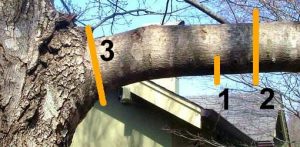Written by Home Guides and published on https://homeguides.sfgate.com/.
If you’re trimming heavy tree limbs, you have to be extra careful not to damage the bark or interfere with the tree’s natural healing response. Doing it right is actually no more difficult than doing it wrong, particularly if you think ahead to how much work it would take to remove a dead tree!
How to Prune Large Trees
 Large trees need little maintenance. If the tree has dead branches or limbs that are rubbing together, however, you should prune the affected wood. You can prune any time of the year, but it’s easier to do when the tree doesn’t have leaves. Avoid pruning in the spring right after the tree produces leaves, as the tree’s energy supplies are already depleted from the new growth and pruning puts additional stress on the tree. Make cuts on the limb side of the branch collar, which is the junction of the tree branch with the tree trunk.
Large trees need little maintenance. If the tree has dead branches or limbs that are rubbing together, however, you should prune the affected wood. You can prune any time of the year, but it’s easier to do when the tree doesn’t have leaves. Avoid pruning in the spring right after the tree produces leaves, as the tree’s energy supplies are already depleted from the new growth and pruning puts additional stress on the tree. Make cuts on the limb side of the branch collar, which is the junction of the tree branch with the tree trunk.
2. Create a second cut slightly farther out on the branch from the first cut. This time cut through the branch from above. Finish cutting the branch by making a clean cut just outside the swollen bump of the tree’s collar.
3. Examine joints on branches to help determine which live branches to thin. Limbs with U-shaped formations on the branches are healthy and should remain on the tree; remove limbs with V-shaped branches along them. Locate all branches that rub or cross other branches. Prune them back to the nearest healthy U-shaped union.
4. Raise the crown of the tree by pruning lower branches. Cut away branches that make it hard for you to walk under the tree or get under it with the lawn mower. As you raise the crown, keep two-thirds of the entire tree as crown and one-third as trunk.
5. Cover the fresh cuts on the trunks of elm and oak trees with non-toxic wound dressing if you prune those trees during the growing season. Otherwise, let the tree heal its wounds naturally.
6. Clean your saws with disinfectant after you prune each tree to help prevent the spread of disease from one tree to another. Mix one part bleach to nine parts water. Rub that mixture on the saw blades and let it set for a couple minutes. Follow that with a mixture of dish detergent and water. Rinse the blades well with clear water and dry them completely.
Original post here https://homeguides.sfgate.com/prune-large-trees-38897.html.

